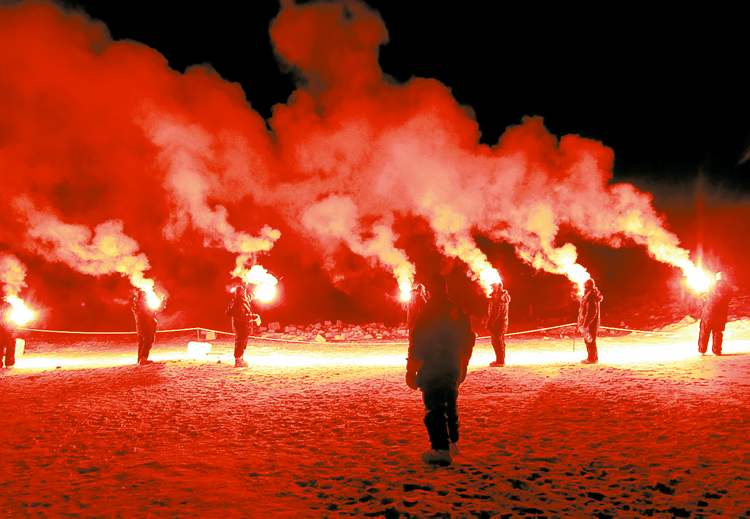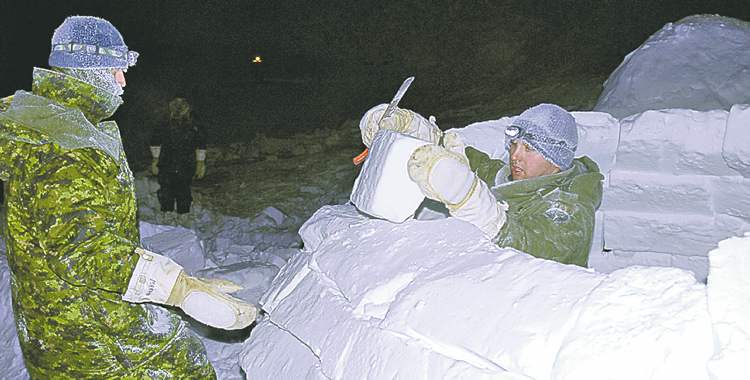Aircrew learn how to survive in High Arctic
RCAF program run by 17 Wing
Advertisement
Read this article for free:
or
Already have an account? Log in here »
To continue reading, please subscribe:
Monthly Digital Subscription
$0 for the first 4 weeks*
- Enjoy unlimited reading on winnipegfreepress.com
- Read the E-Edition, our digital replica newspaper
- Access News Break, our award-winning app
- Play interactive puzzles
*No charge for 4 weeks then price increases to the regular rate of $19.00 plus GST every four weeks. Offer available to new and qualified returning subscribers only. Cancel any time.
Monthly Digital Subscription
$4.75/week*
- Enjoy unlimited reading on winnipegfreepress.com
- Read the E-Edition, our digital replica newspaper
- Access News Break, our award-winning app
- Play interactive puzzles
*Billed as $19 plus GST every four weeks. Cancel any time.
To continue reading, please subscribe:
Add Free Press access to your Brandon Sun subscription for only an additional
$1 for the first 4 weeks*
*Your next subscription payment will increase by $1.00 and you will be charged $16.99 plus GST for four weeks. After four weeks, your payment will increase to $23.99 plus GST every four weeks.
Read unlimited articles for free today:
or
Already have an account? Log in here »
Hey there, time traveller!
This article was published 07/02/2013 (4665 days ago), so information in it may no longer be current.
The renewed Canadian military presence in the High Arctic has led the Royal Canadian Air Force to relearn old lessons about survival in the world’s most inhospitable climate, one wet sock at a time.
In January, 44 air force personnel from bases across Canada underwent Arctic survival training at Resolute Bay, Nunavut, the second-most northerly permanent settlement in North America. The 10-day course constituted the first High Arctic survival training for regular aircrew in 18 years.
During the Cold War, when the Canadian Armed Forces planned for the prospect of a Soviet incursion, Arctic survival training was conducted regularly for many units of the military. But the collapse of the Soviet Union led to military budget cuts that included the end of High Arctic survival lessons for regular aircrew in 1995.

Now, Ottawa is attempting to reassert Canadian sovereignty over Nunavut’s vast Arctic archipelago by conducting more training exercises and expanding permanent facilities at Resolute Bay. To deal with the possibility of a crash in the remote Arctic, the RCAF has embarked on a plan to ensure at least one member of every flight operation in the area knows how to contend with a survival situation in a landscape with no trees to serve as shelter or firewood, only a few hours of winter daylight and bitter January lows.
“We need to get better at this as an air force,” said warrant officer Dave Lazarowich, the Arctic course director for the Canadian Forces School of Survival and Aeromedical Training, based at 17 Wing Winnipeg.
From 1996 until last year, only air force search-and-rescue technicians based at 19 Wing in Comox, B.C., undertook Arctic survival training. In January, two groups of 22 other aircrew spent 10 days in and around Resolute Bay, including four nights in the fully exposed McMaster River valley several kilometres north of the town’s airport.
The course aims to allow personnel to survive in the open Arctic for 72 hours, the maximum time stranded aircrew should expect to wait for a rescue. With the help of a pair of Inuit experts, pilots, flight engineers and combat experts learned how to cut snow blocks and build igloos. They also learned how to build snow walls, dig snow caves into hillsides and set off signals for rescue teams.
Most importantly, they learned how to handle their clothing to avoid getting wet in an environment where that will quickly lead to hypothermia.
“We learned we had to really get down to basics,” said Lazarowich, referring to lessons such as the need to constantly change socks, vigilantly brush away snow and strip off sweat-inducing extra layers while conducting strenuous activities such as cutting blocks of snow.
Course participants, including crew stationed in cities much warmer than Winnipeg, also got the opportunity to contend with the psychological aspects of surviving in extremely cold temperatures.
Maj. Yves Soulard, the commanding officer for the school, said it will take several years before the RCAF meets its goal of conducting Arctic survival training for at least one member of every crew that may be deployed to the region.

The school’s existing winter-training facility in Nopiming Provincial Park can not approximate the deep-snow conditions of the High Arctic or the absence of trees and extreme cold.
In most survival settings, first aid is the No. 1 priority and creating a fire or other heat source ranks No. 2. But in the wide-open Arctic, building a shelter ranks above building a fire, Lazarowich explained. “In the Arctic, shelter ranks above heat,” he said.
Resolute Bay, the epicentre of the Canadian military’s High Arctic operations, has average January lows of -36 C and only one month, July, with no sub-zero temperatures.
bartley.kives@freepress.mb.ca

